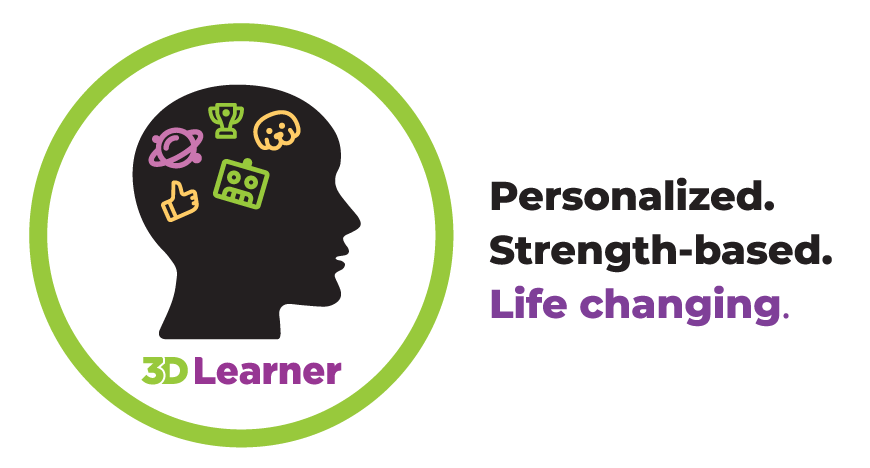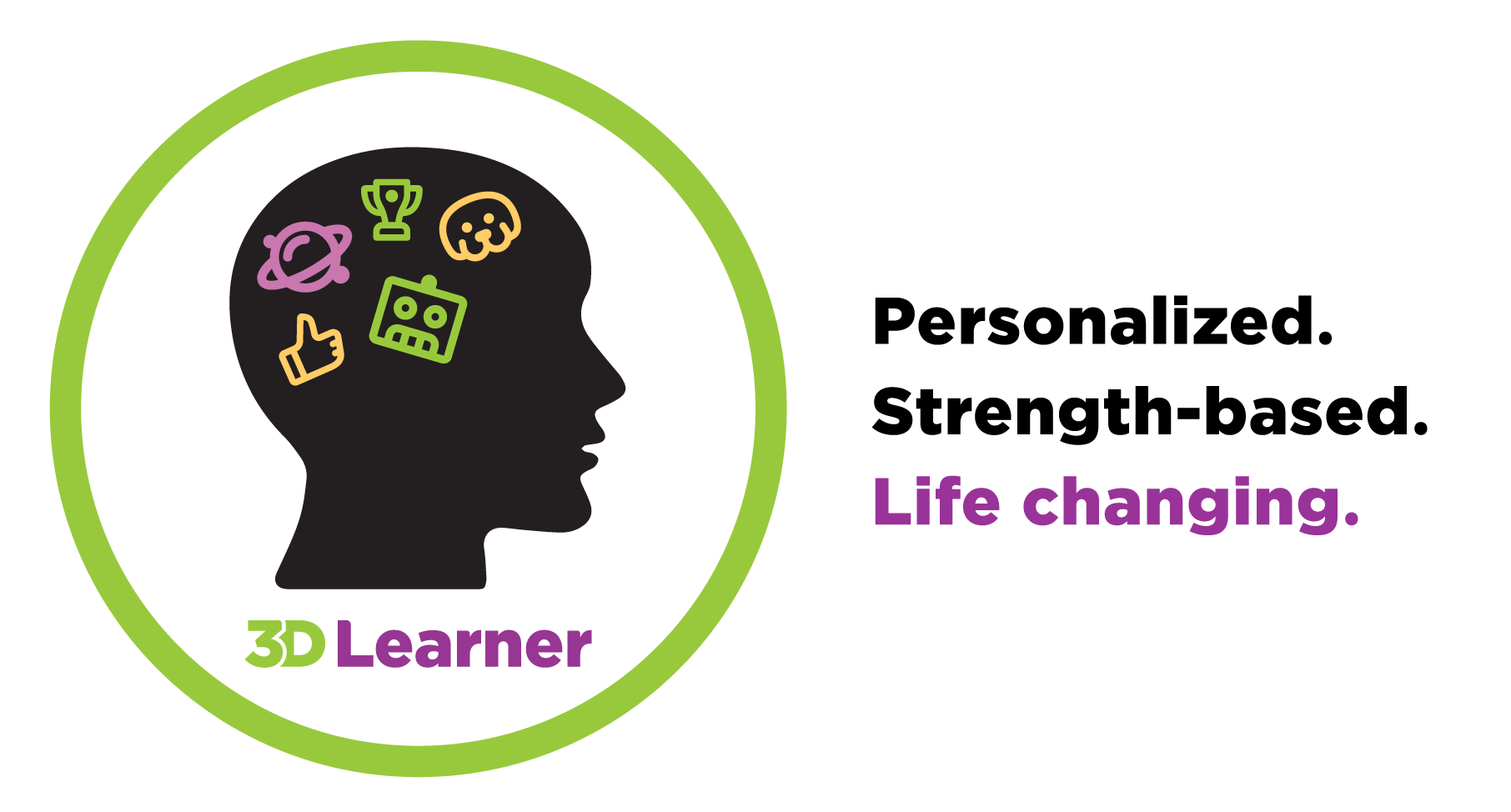
If your child is struggling at private school, especially in elementary school, there is a good chance they:
- Are a right brain or visual learner
- Are below grade level in reading comprehension
- Have executive function challenges
- May have anxiety and/or behavioral challenges
If this describes your child, we have found that they can be far more successful with strategies that:
- Capitalize on their strengths to improve their reading comprehension and love for learning
- Identifies and addresses the relevant challenges
- Is designed to help them maximize their potential
Is your child a right brain or visual learner? Have you noticed that they:
- Remember places visited, even from years ago?
- Learn best when they see and experience information?
- Have a reading comprehension level well below their peers?
These creative “out of box” learners are the students we help.
The challenges for them at private schools are:
- The best private schools often pride themselves for having a more rigorous curriculum and being a year ahead of public schools, This makes life much harder for the smart struggling right brain or visual learner
- Their tutoring programs are often limited and one dimensional. This approach is hard for a right brain or visual learner who often does not have a good working memory, skips words and lines when reading and/or is bored with the process
- In many States now, the demand for private school seats exceeds the supply, and they can simply say “we do not have the resources to help your child.”
- We are seeing more private schools than ever suggesting to parents that their child may not be right for their school.
If your child is struggling at a private school and you want to understand what can be done to improve their performance, give us a call at 561-361-7495 and or click here to schedule a Private School Conversation.
The good news is your right brain or visual learner can often succeed
Donna called us with this exact problem. Her third grader was two years below grade level and his private school was suggesting they go elsewhere. Donna found us on the internet and called us. After a 10 minute conversation she commented, “How is it that after 10 minutes, you appear to know my child better than people who have known him for years?’
We explained that our specialty is working with kids like her son who are:
- Far smarter than their present level of reading comprehension would indicate
- A right brain or visual learner
- Appear to have working memory and attention challenges.
With our help, he was able to make significant gains over the summer and stay in that private school. The testing the next year showed he had improved his reading comprehension 3 grade levels in a year. His teacher commented, “Bobby made more progress in a year than any student I have had in 27 years of teaching”.
We have had many similar cases including:
A student whose parents were told to hold their child back. She went from one of the weakest readers in her class to the top reading group after completing our program. Even better, in a reading contest over a month, she read 720 pages, while the second place reader read only 374 pages and the average student read 172 pages. When her mom asked her how she went from a non reader to an avid reader she commented, “3D Learner taught me how to visualize what I read, do you know how cool that is?”
A parent was told, by a professional, not to even consider a private school where the work would be too demanding. With our help, their son went from the 58th to the 99th percentile in reading comprehension. He went on to become valedictorian at that prestigious private school and proceeded to graduate from Harvard.
Note: in this case, the psychologist had recommended two more dyslexia treatments. After he mom said these types of programs did not help her son and asked if there was a different approach, the psychologist then recommended 3D Learner.
A word of caution. Sometimes the school is right. For the right brain or visual learner with a below average IQ, the most demanding private school may not be the right place. These cases happen and we work with parents to find the right place for their child.
Note: the catalyst for the 3D Learner Program ® was when we were told our daughter had limited potential and was not “college material”. She is now close to completing her Doctorate in Education. We love helping kids to succeed whose parents have been told something similar. No one has the right to put limitations on what kids CAN DO! The right brain or visual learner can often make far more progress than others thought possible,
If your child is struggling at a private school and you want to understand what can be done to improve their performance, give us a call at 561-361-7495 and or click here to schedule a Private School Conversation.

How to significantly improve reading comprehension within 4 to 6 months
Reading comprehension issues have become even more pressing since the pandemic started.
- As always, we are seeing students with dyslexia and learning disabilities who are far behind. With the pandemic, the reading comprehension gap has widened for many of these kids
- For the first time, we are seeing many smart kids with no disabilities, who go to excellent schools, who are 2, 3 and even 4 years below grade level
- Schools have done what they can this year, but it has not been enough
5 Keys to Reading Comprehension Success
- If your child is a lot smarter than present results indicate, and you want your child to start the new school year with much higher reading comprehension skills, you must take action now.
- Reject the status quo and consider the mantra that “Reading Comprehension Success is the Only Option”
- Identify your child’s strengths and challenges.
Most smart struggling students:
- Learn differently. They are often a right-brain or visual learner. They learn best when they see and experience information
- Have a combination of challenges that might include – working memory, processing speed, visual processing, attention and/or anxiety.
- Struggle with traditional interventions that don’t capitalize on their visualization skills or identify and address the related challenges
- Can do far better with an approach that:
- Plays to their strengths and interests
- Identifies and addresses their challenges
- Ignites a love for learning that is often missing
- Helps you to be the coach and advocate your child needs
Download our strengths and challenges inventory with 10 common strengths and 10 common challenges our students have.
We offer a no cost conversation on
“How to Improve My Child’s Reading Comprehension”.
Call us at 561-361-7495 or click her to schedule a conversation
4- Goals matter. If your child is much smarter than present results would indicate, this spring/summer is an excellent time to catch up.
Important points to consider when setting goals and choosing a program:
- Significant negative news on reading comprehension can be a catalyst for taking action. That is exactly how the 3D Learner Program ® came to be. We never doubt the ability of a committed mom or dad to make the difference
- Parents are often shocked to hear that it may take 2, 3 or even 4 years to get your child’s reading back to grade level. These programs are often phonics-based programs that can take a long time.
- The 3D Learner approach is to significantly improve comprehension in 4 to 6 months. Most of our students are either right-brain or visual learners who have struggled for years with traditional interventions.
- Three things that make these students different are:
- They learn best when they see and experience information
- They can often struggle with working memory, processing speed, attention, visual processing and/or anxiety issues
- When one capitalizes on their strengths, identifies, and addresses their challenges, they can make significant gains in months not years
5- What is the difference between reading and reading comprehension?
Reading and Reading Comprehension are two very different skills
Reading is often defined as how efficiently and effectively a student reads, while reading comprehension is understanding what one reads. Reading level and reading comprehension levels can differ by years.
Many parents are told that their child’s reading is not that bad. When we assess their child, the parents are often surprised to discover how far below grade level their child’s reading comprehension is.
The challenge is that schools often use reading levels and not reading comprehension levels. A 5th grade parent was told her child was reading on grade level, and that was true.
What the teacher did not mention was the student’s reading comprehension was at the 1st grade level
Ask your child’s teacher to clarify your child’s present level of reading and reading comprehension!!
How Knowing Your Child’s Reading Comprehension Can Be a Catalyst for Action
“From her I-Ready score I knew my child had a reading problem. I-Ready is a computerized program used by many schools. When you tested my daughter’s reading comprehension and discovered it was was 3 years below grade level, I was ready to act”, “M James, Boca Raton.
Other catalysts can be:
- Grade retention risks. A parent called us almost at the end of last year’s school year when their child’s teacher recommended grade retention. The issue was primarily reading comprehension. When asked if it was too late to help, we responded, “No, if you act quickly”. The parents did. With our help, within 4 weeks the teacher commented “He is making so much progress I can’t possibly hold him back,”. By the end of the summer the young man’s comprehension was ahead of grade level
- Pressure from private schools is higher than ever. One young man was 2 years below grade level in third grade. The private school recommended the parents find another school, even though the young man had an above average IQ. He appeared to be a right-brain or visual learner, and he had parents committed to make the difference. With our help, over the next year, he improved his reading comprehension 3 grade levels. His teacher commented,
“Jack made more progress in a year than any student I have had in 27 years of teaching”.
One mom knew her child was a lot smarter than present results would indicate. She asked the principal what she could do to improve her daughter’s reading comprehension. He responded, “There is no need to do anything different. Her comprehension is at the 48th percentile and someone needs to be average”.
Mom joined our community of “Make the Difference Moms”. Within a year her daughter’s reading comprehension had gone from the 48th to the 95th percentile. Even better, her grades improved, even though she was taking harder classes.
Two keys to Reading Comprehension Success are:
- A Mindset shift that you want to significantly improve your child’s reading comprehension ASAP.
- Assessing your child’s strengths and challenges. You want to consider a program that capitalizes on your child’s strengths, identifies their interests and has a track record of significantly improving reading comprehension for kids like yours.
To Improve Reading Comprehension
First download our Strengths and Challenges Inventory. It will give you valuable insights into your child’s strengths and challenges. If the need is urgent, we recommend you contact us immediately to discuss your situation.
Click here to download our Strengths and Challenges Inventory
We offer a no cost “How to Improve My Child’s Reading Comprehension” conversation.
Call 561-361-7495 or click here to schedule a conversation

Words can confuse and overwhelm many children. Confusion inevitably leads to frustration, for both the students and their parents. This is especially true for kids who learn differently. Traditional written and verbal instructions are often the reason why smart students can struggle in school.
Most of the bright, creative students we work with are right-brain learners who are trying to figure out how to function in a left-brain world.
- Right brain learners usually think in pictures and are often confused by too many words. Long explanations can be problematic.
- As smart as they are, they often cannot understand the language to create a picture of what is being asked. If they misunderstand your directions, they are likely to do the wrong thing.
- They get frustrated or anxious by their inability to do homework or other activities correctly because they just ‘can’t picture’ the problem or solution. Once they see the challenge, they can solve it.
Picture another approach
One of the easiest ways to help a right-brain learner understand a situation is to use visual descriptions, not just words.
Once, when playing golf with my son, he asked me where to hit a golf shot. I told him “15 feet to the right of the tree.” That description was not clear enough for him. So he hits his ball directly to the tree because the concept of 15 feet just didn’t register with him.
On the next hole, he asked the same question and I responded, “Hit towards the water tower.” Though the tower was far off, it gave him the perfect line to the target. Of course, he hit it right towards the tower, a perfect shot. He could easily follow the instructions that created the right picture in his brain.
Conveying clear consequences helps, too. For example, at a swimming pool, you may tell your child “Don’t run” but the word ‘don’t’ doesn’t register with many kids. But shifting your instructions to “walk slowly so everyone is safe’ is likely to be far more effective.
Try giving your child the right picture of what you want and why and keep it short. Once you get in the habit of using words that create clear direction, you’ll see dramatic improvement.
Stay calm
Raising a right-brained learner in a left-brained world poses many challenges. You know how easily your child can get frustrated or closed off. It’s only natural when that happens for you to get frustrated as well. But it is essential to always try to stay as calm as possible. Stepping back, taking a deep breath, and continuing to talk calmly and sensitively will do far more to alleviate the situation. If your child senses you are frustrated, they will pick up on and magnify that negative energy.
3D Learner has developed tools that can help both students remain calm and resilient in the face of frustration.
Wouldn’t it be great if everyone could just stay calm, cool, and collected?
If we want our kids to remain calm and capable then we, as parents, need to model that behavior. But even the best of parents can lose it. When we do, apologizing is something kids need to see to learn how they can do it, too.
So next time you feel yourself starting to reach your wit’s end, consider the following:
Take a deep breath and wait a bit before you talk. This will give you the time to collect yourself and come up with another way to approach the situation. A technique a famous quarterback uses on the sidelines is 4 count breathing. Take a deep breath for a count of four. Then hold it for another 4 counts. And then exhale for a count of four. It’s an amazingly effective technique.
Keep your voice low and calm (as much as you may want to scream!) Kids are listening to our tone WAY more than they are listening to our words. Right-brained learners tend to mirror or copy what they see/experience.
Surround yourself with calming things (artwork, imagery, knickknacks, etc). Just the way your child learns visually, you may too. When you feel stress rising, spend some time observing and appreciating calming artwork. You can have a private shrine or place them all around the house to help everyone. It doesn’t matter whether it’s a landscape, a family portrait, a favorite painting, a beloved quilt, it can be anything so long as it helps you relax.
Challenge yourself. Set a goal of staying calm for X amount of days and see how you do. How about for a week to start? Track how your progress each day. You’ll find once you get into the habit, it can stick.
Ask for help. If you feel stress rising too frequently, talk to people about it. Tell a close friend or family member how the stress makes you feel and what triggers it. From coffee with your best friend to yoga classes to therapy, there are more options for support than you can imagine. We’re happy to talk with you, too.
If you would like to have a conversation on your child’s strengths, challenges, and how you can make the difference, you can either call us at 561-361-7495 or book time on our calendar here.

Bright, creative kids with learning difficulties may underperform at school. They know they’re smart but somehow they can’t quite understand what the teacher is explaining. What is important to understand is that these right brain children often struggle with reading comprehension, math, and executive functioning. It is not because of their ability. It’s because they are right-brain learners trying to make their way in left-brained classrooms.
These struggles lead to frustration, a loss of confidence, and difficulties in school. Yet all the while, you know you have a bright, creative child.
We help parents end the cycle of frustrations
After working with thousands of students, we know that concerned parents can make a difference by using a strength-based parenting approach to your child reach their full potential.
Strength-based parenting starts with the question “What is right with my child?” It is a parenting style that builds up strengths and assets before it seeks to address problems and weaknesses.
Strength-based parenting is not about ignoring or unrealistically turning a blind eye to the downsides; it’s about where you place your attention first. When you focus on strengths before weaknesses, you can help your kids use what they’re good at to overcome their learning difficulties.
How many of these strengths does your child possess?
Here are twelve strengths we often find in the bright right-brain learner. How many does your child demonstrate?
Strengths of right-brain learners
- Learns best when they see and experience information
- Good problem solver
- Creative and comes up with new ways to do things
- Observant
- High levels of empathy – they often relate well to small children animals, older adults
- Excellent big picture thinkers
- Good at making connections
- Strong narrative reasoning
- Three-dimensional thinking
- Respond well when their questions are answered
- Work best when the work is relevant and interesting to them
- Able to excel when they are taught in a way that is strength-based and engaging and their challenges are addressed
What challenges is your child facing?
Here are some of the usual learning issues right-brained issues manifest. They become much easier to overcome when you use your child’s strengths as a launchpad for success.
- Difficulty learning and remembering high frequency or sight words — that do not generate a picture
- May not recognize words they have seen before and not mastered – their working memory is often weak
- Get overwhelmed with too many words
- Often struggle with logical, sequential, and auditory programs
- Do not respond well to people who talk down to them or do not understand them
- Can respond negatively to facial expressions or what they perceive as the wrong tone of voice
- Language — they have often not developed vocabulary, since they avoid reading
- Often skip words and lines when reading
- Their memory for what they hear or read is often weak — sometimes called working memory
- May struggle to pay attention when the work is boring or frustrating
- May be very anxious or frustrated
- Silent reading comprehension is often very difficult for these students
If you want to take more time to assess your child, call us at 561-361-7495
Right brain learners can often be quite articulate – and clever – about the disconnect between what you are saying and what they are thinking.
Some of the things kids say that are often clues about their learning needs (and how clever they may be) include.
- I’m not stubborn….. I’m thinking about the picture in my head
- I’m not losing focus….. I just don’t understand anything you are saying
- I’m not bossy…. I’m just telling you the way I would do this
- I’m not lost… I just found a different way to go
- I’m not mad…. I just don’t know what words to use when I’m frustrated
- I don’t know HOW to Do this problem… BUT I’m very good at thinking of ways to get away from it
What can you do to help?
Dealing with a learning difference begins with open, non-judgmental communication. Sit down with your child and your spouse and discuss the list of strengths and challenges. Observe your children to identify strengths and weaknesses in their learning styles.
Also, think about the times your child enjoys learning. Do they have specific interests that really excite them, subjects that they just can’t learn enough about? What do you think made those moments so educational for your child? Was it a hands-on experience giving them items to touch? Was it driven by words or by pictures?
A strength-based approach to education uses your child’s natural strengths and interests to inspire learning of all types. Such an approach effectively engages children and their successes and enjoyment in turn lowering anxiety and building self-esteem. Best of all, once your child has renewed confidence and new learning strategies, school becomes a place of learning, not frustration.
If you would like to have a conversation on your child’s strengths, challenges, and how you can make the difference, call us at 561-361-7495 or book a time here.






Recent Comments